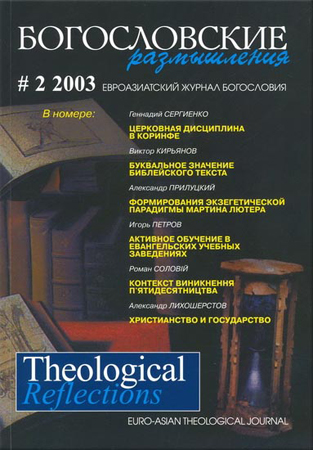Существует ли одно, буквальное значение библейского текста, которое может обнаружить толкователь?
Keywords:
Буквальное значение библейского текста, значение библейского текста, толкование библейского текстаAbstract
Целью данной работы является рассмотреть критически существующие сегодня точки зрения по проблеме значения текста. В богословских кругах проводятся постоянные дебаты в отношении того, а если в тексте значение. И если есть – как его обнаружить. И если оно присутствует, то одно ли значение присутствует в каждом тексте или их может быть несколько. В данной работе будут рассмотрены три основных подхода к определению значения текста: подход, направленный на читателя, подход, направленный на автора, и подход, направленный на текст. В каждом подходе будут рассмотрены аргументы за и против каждого подхода и в конце будет предложено мнение автора.References
- Barr, James. “The Literal, Allegorical, and Modern Biblical Scholarship. ”Journal for the Study of the Old Testament 44 (1989): 3-17.
- Barthes, Roland. “From Work to Text.” In Textual Strategies: Perspectives in Poststructuralist Criticism, ed. Josue V. Harrari, 73-81. Ithaca, NY: Cornell University Press, 1979.
- Brown, Raymond. The Sensus Plenior of Sacred Scripture. Baltimore: St. Mary’s University Press, 1995.
- Caird, G.B. The Language and Imagery of the Bible. Grand Rapids: Eerdmans, 1997.
- Cotterell, Peter and Max Turner. Linguistics and Biblical Interpretation. London: SPCK, 1989.
- Croatto, Severino. Biblical Hermeneutics: Toward a Theory of Reading as the Production of Meaning. Maryknoll, NY: Orbis, 1987.
- Fish, Stanley. “Interpreting the Variorum.” In ReaderResponse Criticism, ed. Jane P. Thompkin, 164%184. Baltimore: Johns Hopkins Press, 1980.
- ________. Is There a Text in This Class? The Authority of Interpretative Communities. London and Cambridge: Harvard University Press, 1980.
- Gillespie, Thomas W. “Biblical Authority and Interpretation: The Current Debate on Hermeneutics.” In A Guide to Contemporary Hermeneutics, ed. Donald K. McKin. Grand Rapids: Eerdmans, 1986.
- Goldingay, John. Models for Interpretation of Scripture. Grand Rapids: Eerdmans, 1995.
- Hirsch, E.D. Validity in Interpretation. New Haven: Yale University Press, 1967.
- ________. The Aim of Interpretation. Chicago: The University of Chicago Press, 1976.
- Kaiser, Walter C. “The Single Intent of Scripture.” In Evangelical Roots: A Tribute to Wilbur Smith, ed. K.S. Kantzer, 55-69. Nashville: Nelson, 1978.
- Klein, William W. Introduction to Biblical Interpretation. Dallas: Word, 1993.
- LaSor, W.S. “The Sensus Plenior and Biblical Interpretation.” In A Guide to Contemporary Hermeneutics, ed. Donald K.McKim. Grand Rapids, MI: Eerdmans, 1986.
- McKnight, Edgar V. “Reader-Response Criticism.” In To Each Its Own Meaning, ed. Steven McKenzie. Louisville, KY: Westminster/John Knox Press, 1993.
- Osborne, Grant R. The Hermeneutical Spiral, A Comprehensive Introduction to Biblical Interpretation. Downers Grove, IL: InterVarsity Press, 199?
- Poythress, Vern Sheridan. “Divine Meaning of Scripture.” Westminster Theological Journal, 48 (1986).
- Recoeur, Paul. Interpretation Theory Discourse and the Surplus of Meaning. Fort Worth: The Texas University Press, 1976.
- Thiselton, Anthony C. The Two Horizons: New Testament Hermeneutics and Philosophical Description. Grand Rapids: Eerdmans, 1980.
- ________. New Horizons in Hermeneutics. Glasgow: Harper Collins, 1992.
- Vanhoozer, Kevin J. Is There A Meaning In This Text? Leicester, England: Apollos, 1998.
- Vercler, Henry. Hermeneutics (Russian Edition). Grand Rapids, MI: Baker, 1995.
- Voelz, James W. “Multiple Signs, Levels of Meaning and Self as Text: Intratextuality and the Bible.” Semeia 69-70 (1995).
- Yoder, Perry B. Toward Understanding the Bible. Newton, KS: Faith and Life Press, 1978.
Downloads
How to Cite
Issue
Section
License
Copyright (c) 2020 Виктор КИРЬЯНОВ

This work is licensed under a Creative Commons Attribution-NonCommercial 4.0 International License.
All articles published in the Journal are distributed under a Creative Commons Attribution-NonCommercial 4.0 International License
By submitting an article for publication in Theological Reflections: Eastern European Journal of Theology the author grants the editors the right to publish the article and distribute it in electronic and print form.
The author reserves all copyrights and the right to use the materials of the article in whole or in part for educational purposes, to write his own dissertations, to prepare abstracts, conference reports, oral presentations, etc., as well as post electronic copies of articles (including the final electronic version downloaded from the journal’s official website) on non-commercial web-resources without the consent of the editorial board and founders.



